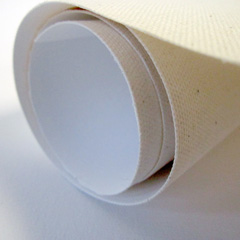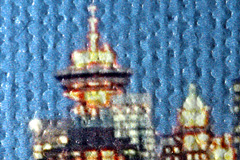At KeenART Media, we don’t just print on canvas; we’re really very passionate about this age-old substrate in general. And why not? Canvas is a pretty cool material.
A Brief (somewhat fictionalized) History
Canvas beat out stone and wood as the best artistic base somewhere around the early 1500s. I won’t say artists were mobbing passing cargo transits and tearing protective tarps from military supply carts to use for scenes of Venus emerging from the sea but … I bet some did.
Once art printing came about, it didn’t take manufacturers long to realize those savvy artists had it right – canvas is a great surface for recreating beautiful artistic images. Today, consumers love the authentic look canvas gives to fine art prints – almost as though it were an original.
Kinds of Canvas

Let’s talk about the canvas used in Giclée printing. There are a few different options, and each one has its reason for being.
- Polyester canvas is the least costly canvas option. Because it is synthetic, it has a smoother texture, which appeals to some photographers who want a less “painterly” texture that ensures all the fine details are clearly visible.
- Polyester-Cotton canvas is probably the most popular option. It combines the organic texture and softness of the cotton artists have been painting on for centuries with the color consistency that only a natural material just can’t guarantee (particularly useful for multiple copies of the same image).
- Cotton canvas is available to printers as well, and is very much like the high quality canvas used by professional artists. The natural fibers make for a beautiful, deep texture, but like I pointed out above, it is impossible to guarantee consistency from one print to the next.
In addition to these base materials, different weaves can affect the appearance of the canvas. If you want to learn more about weaves, check out our comprehensive article All About Canvas (you will be redirected to our website).

Pre-Printing Considerations
So, are you as intrigued by canvas as we are yet? I figured as much.
Canvas Size
The largest size at which your printed artwork can be recreated on canvas depends on a number of factors, like the quality (resolution) of the digital image and the width of the printer. But rolls of canvas can’t be infinite in width, either.
Rolls of printer canvas come in widths as long as 60 inches, sized to correspond with different common printer widths. This limits your artwork width to about 55 inches, to allow space for wrapping the canvas afterwards.
That’s five feet, but if you’re a fan of really massive prints, don’t run off just yet. Remember, the canvas comes on a roll, which means you have about 40 feet of print length. Not that I’d recommend a 40×5 foot canvas to anyone.
Coatings
Because printing on canvas is a different process than painting, the surface must be treated with an ink-receptive coating prior to passing through the printer. (Actually, usually prior to even being rolled, back at the manufacturer.)
Different coatings give the printer and customer options on the final look of the print:
- Matte coating: More muted colors with low reflectivity. It is popular when the art is being hung in a well-lit space where reflections/glare could interfere with viewing. Not ideal for brightly colored prints, but using a glossy finishing spray can counteract this.
- Satin or Lustre coating: A brighter finish that still reduces the amount of glare from lighting. Essentially “semi-matte,” or “semi-gloss.”
- Glossy coating: Generally avoided in inkjet printing, because the coating can crack when the canvas is stretched. Many print shops just use matte and save the gloss for the finishing spray.

After Printing
Once the image has been printed onto a high quality poly-cotton, matte-coated canvas, there is one more step before it’s ready for stretching or shipping.
The finishing spray I mentioned above is useful both aesthetically and practically. Different finishes are available, but the glossy version we use at KeenART Media gives your artwork a beautiful shine, without a distracting glare like some framed prints.
The coating is also protective. It makes the piece water resistant, protects against UV damage (as do the inks), and ensures your print remains scratch- and scuff-free. It also saturates the colors, making those reds bolder, and those blacks richer.
So, isn’t print canvas neat? It’s super easy to just order online, too. In a few days time, you could have a beautiful canvas print of your favourite painting, drawing, or photograph.
Why not contact us today; we’re always happy to answer your questions and discuss our services!
